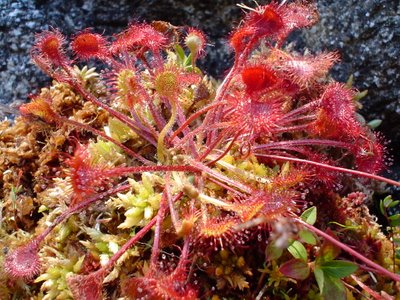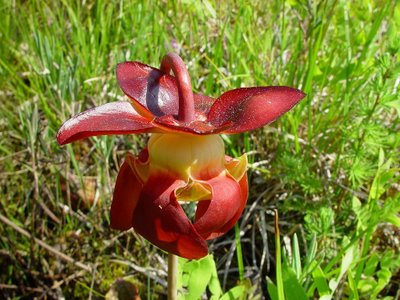So what about the Venus Flytrap? Is it an exception to this law of nature? Venus Flytraps are carnivorous, or meat-eating, plants. A fly that lands on a Venus Flytrap had better beware. A fly that lands on a Venus flytrap is history; it's lunch, a protein packed meal for a plant. Venus's-flytrap is probably the most recognizable of all sundew plants. It has hinged leaves that close and trap insects venturing into the open trap. The inside of each leaf has tiny hairs, and the rim is edged with long interlocking, stiff bristles. The closing of the trap is triggered by any pressure applied to six hairs, three on either side of the traps lobes. After the plant has captured the insect, a sap is secreted and digestion begins, which can take up to ten days. After the insect is digested the trap opens again to await the next victim. The trap will usually die once three or four insects are digested.
The Venus Flytrap is not an exception to the laws of nature. It is one of over 600 types of carnivorous plants! Carnivorous plants are like other plants in many ways. They even use photosynthesis to make most of their own food. They are carnivorous for a reason. Most carnivorous plants live in swampy wetlands. This environment does not provide enough of the nutrients that plants need, especially nitrogen. So these plants have adapted to their environment by developing ways to catch insects for the extra nutrition that they need. It is a survival tool.
 A plant must be able to do three things to be considered carnivorous. It must attract insects or other creatures; it must trap them; it must eat them.
A plant must be able to do three things to be considered carnivorous. It must attract insects or other creatures; it must trap them; it must eat them.Lots of the other meat-eating plants are grouped under the titles sundew, pitcher plant, and bladderwort.
 Sundew plants grow hairs on their leaves that produce a sticky substance that contains digestive juices. When an insect gets stuck on this substance, the hairs wrap around it or the leaves close. More fluid then covers and suffocates the insect which is then digested by the plant.
Sundew plants grow hairs on their leaves that produce a sticky substance that contains digestive juices. When an insect gets stuck on this substance, the hairs wrap around it or the leaves close. More fluid then covers and suffocates the insect which is then digested by the plant.  The Sundew plant tempts insects with its sticky drops
The Sundew plant tempts insects with its sticky drops
Pitcher plants have tube-shaped leaves that collect rain water in which the unsuspecting insects are drown. A sweet nectar secreted around the rim of each tube on the pitcher plant attracts insects. When the insect enters the tube, tiny, stiff hairs pointing downward prevent it from escaping and eventually force the exhausted insect into the water. The plant then digests the insect by means of an enzyme secreted by glands located in the leaves.





i had a small venus fly trap that i bought from a local florist. i put it outside to catch flies and i made sure i watered it daily. theyre really interesting, but they start to stink once they digest the flies. i wouldnt recommend keeping one in your home!
ReplyDeleteI would like to confess your entire articles appears to be so helpfulas they givegood advices.Wishing u all the best for your upcoming writings and expect them also to help me like this one.And yes i have book mark your site naturesmightypictures.blogspot.com .
ReplyDelete